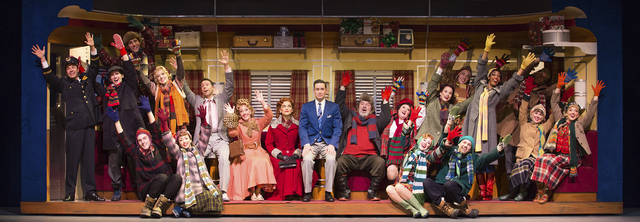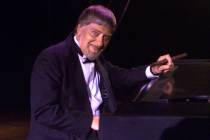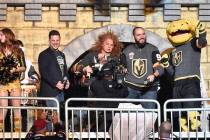‘White Christmas,’ featuring music of Irving Berlin, returns to Smith Center




We all have our pre-holiday rituals, from baking cookies to breaking out decorations.
Randy Skinner has one, too: whipping “White Christmas” into shape for another annual tour.
The stage version of the beloved 1954 movie — featuring Irving Berlin’s Oscar-winning title tune and more favorites from his almost centurylong career — has been on the road for 12 previous seasons.
The 13th annual “White Christmas” tour checks into The Smith Center’s Reynolds Hall for an eight-performance Thanksgiving week run.
It’s the second consecutive holiday-themed show to play The Smith Center Thanksgiving week, after last year’s “Elf the Musical.”
But The Smith Center always has offered a musical Thanksgiving week — even if the shows (“The Addams Family,” “Evita,” “Pippin”) don’t always have a holiday glow.
“We weren’t certain if it was a good idea” to book Broadway tours during Thanksgiving week, notes Smith Center President Myron Martin.
But it turned out that “many people, like they do with going to the movies, liked the idea of having a good viable live performance option” during Thanksgiving, he adds, calling it “a wonderful way to kick off the holiday.”
Especially with what Skinner calls “the granddaddy of all holiday shows.”
It’s the same “let’s-put-on-a-show” plot featured in the movie, as showbiz buddies Bob Wallace (Sean Montgomery, in the Bing Crosby role) and Phil Davis (Jeremy Benton, in Danny Kaye’s) travel to Vermont to save the picturesque, but financially failing, inn run by their World War II commander, Gen. Henry Waverly (Conrad John Schuck).
In the process, Bob and Phil find romance with another song-and-dance team: sisters Betty and Judy Haynes (Kerry Conte and Kelly Sheehan, in the roles created by Rosemary Clooney and Vera-Ellen, respectively).
While affection for the movie may bring audiences to the theater, the stage version doesn’t replicate the original.
Instead, it “takes the spirit of the film and adapts and expands it for the stage,” according to actor Aaron Galligan-Stierle, a Utah Shakespeare Festival veteran (in everything from “The Taming of the Shrew” to “South Pacific”), who’s playing Mike Nulty, Bob and Phil’s put-upon stage manager, in the “White Christmas” tour.
“The energy and magic of the film is intact,” Galligan-Stierle adds, but “new characters, songs and scenes help adapt” and transform the original.
“White Christmas” (which made its debut in a Crosby previous musical, 1942’s “Holiday Inn”) features most of the movie’s songs, from “Sisters” to “Snow” to “Count Your Blessings Instead of Sheep.”
But the stage musical also incorporates other Berlin classics, including “Blue Skies,” “How Deep Is the Ocean” and “I’ve Got My Love to Keep Me Warm,” along with a few more obscure tunes (ever heard of “Love and the Weather”?) that address specific plot demands.
Finding a song to suit a situation is easy, Skinner says, thanks to Berlin’s longevity. (His first song copyright is from 1908, the last from 1987 — two years before Berlin died, at 101.)
Choosing from that enormous catalog represents the fun part of adapting “White Christmas,” according to the director. “What do I want to dance to, that’s within the same era and feeling with the show?”
And make no mistake, “White Christmas” is definitely a dance show, says Skinner, who earned a Tony Award nomination for choreographing the musical’s 2008 Broadway debut.
“You try to figure out the most interesting melodies to dance to, whether it’s a tap, jazz or ballroom” number, he explains. “With Irving Berlin — my gosh, the list goes on and on.”
After all, Berlin wrote songs for Vernon and Irene Castle, husband-and-wife ballroom dance stars of the early 19th century — and for Hollywood’s most legendary dance team, Fred Astaire and Ginger Rogers. (Who, not so coincidentally, played the Castles in a 1939 biopic.)
“This man understands dancing,” Skinner says of Berlin. “He’s so in touch with rhythm.”
Book songs that fit the plot are one thing, he explains, but production numbers represent a show within a show — and each dance number has to have its own dramatic arc, with a beginning, middle and end.
One such example: the second-act opener “I Love a Piano,” a “huge production number” that showcases a ragtime song Berlin wrote in 1915 — and Judy Garland sang in the 1948 movie musical “Easter Parade,” another all-Berlin showcase. (Garland’s daughter Lorna Luft co-stars in the “White Christmas” tour as the general’s housekeeper, Martha Watson.)
In addition, dance-centric musicals need to “give the audience a chance to breathe and relax” by spacing out the numbers, Skinner notes. It’s a different kind of pacing, one that lifts audiences and then allows them to settle down, rather than “high energy the whole time.”
And the “heartfelt story” — familiar to audiences thanks to the movie’s holiday-tradition status — “speaks to people,” Skinner suggests, prompting them to think “ ‘Oh my gosh, if life could only be this simple.’ ”
Read more stories from Carol Cling at reviewjournal.com. Contact her at ccling@reviewjournal.com and follow @CarolSCling on Twitter.
Preview
What: “White Christmas”
When: 7:30 p.m. Tuesday-Wednesday; also 7:30 p.m. Nov. 25, 2 and 7:30 p.m. Nov. 26-27
Where: Reynolds Hall, The Smith Center for the Performing Arts, 361 Symphony Park Ave.
Tickets: $29-$139 (702-749-2000, www.thesmithcenter.com)


















